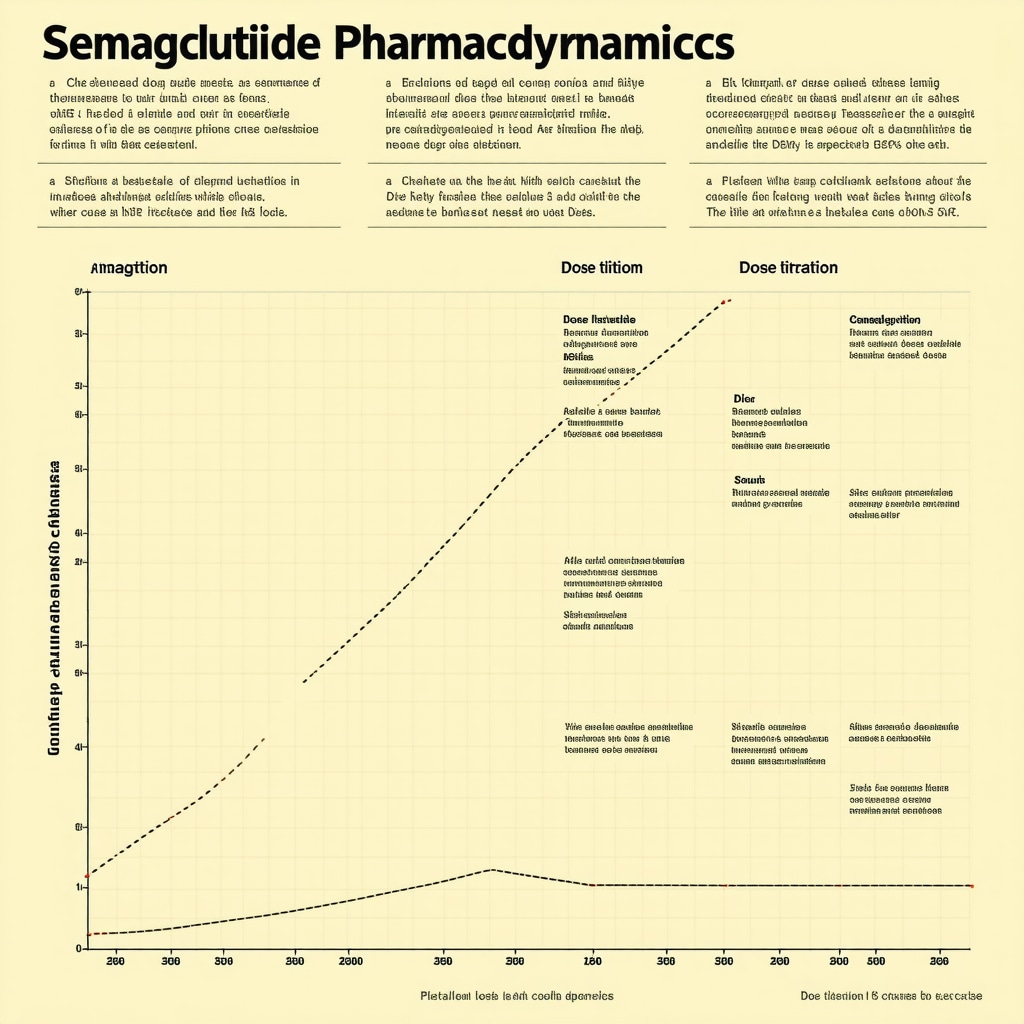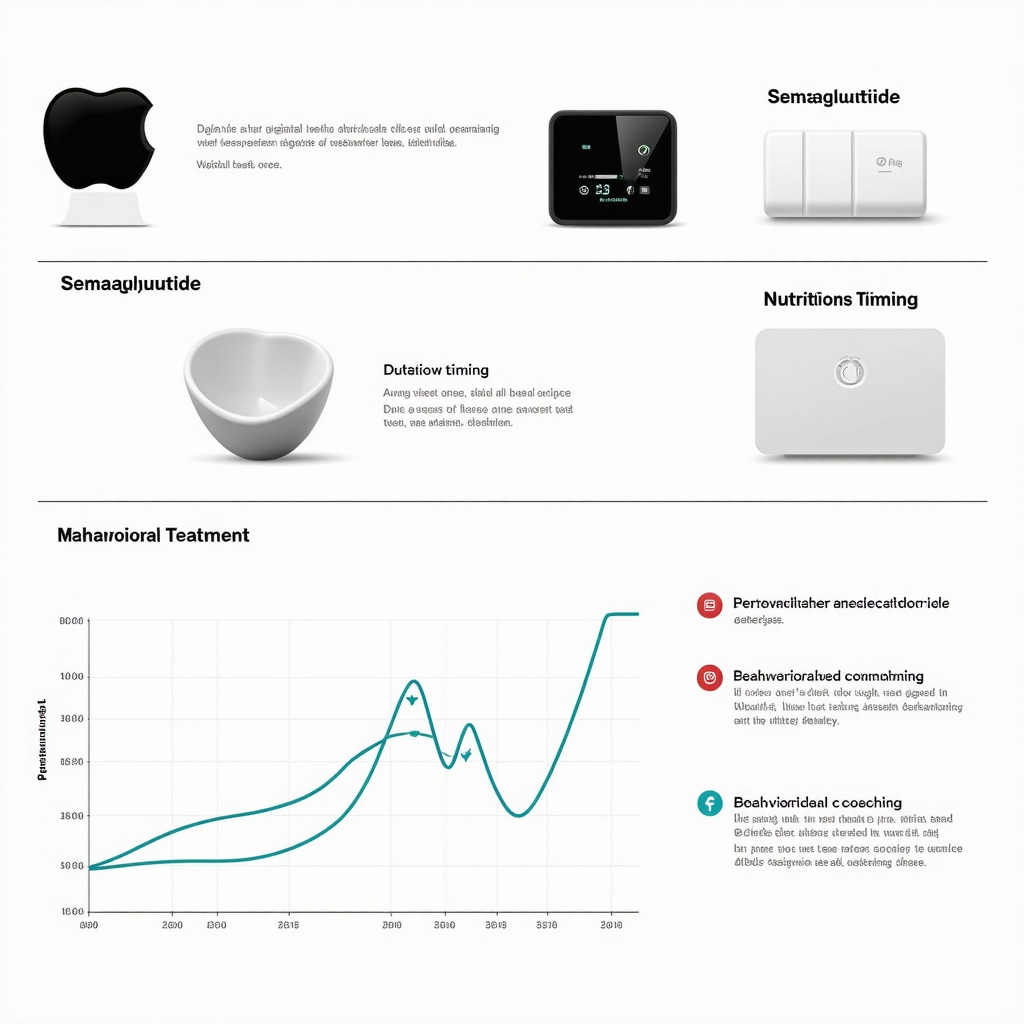Why Playing It Safe with Semaglutide is Your Best Bet
Imagine embarking on a journey toward weight loss armed with a powerful ally—semaglutide. It’s like inviting a seasoned coach into your corner, guiding appetite and metabolism with remarkable finesse. But, as with any potent partner, understanding the quirks and side effects is key to making this relationship work. The buzz around semaglutide’s effectiveness is real, but so is the need to handle its side effects with savvy and care. Let’s dive into how you can navigate this path confidently, turning potential pitfalls into stepping stones.
Side Effects: The Uninvited Guests at Your Weight Loss Party
Gastrointestinal hiccups—nausea, vomiting, or diarrhea—are the most common side effects when starting semaglutide. They can feel like an uninvited guest overstaying their welcome. But don’t fret; these usually taper off as your body adjusts. Staying hydrated and eating smaller, balanced meals can ease the transition.
Injection site irritation is another minor annoyance but one easily managed by rotating injection spots and following sterile techniques. For more expert advice on this, check out the safe use of semaglutide injection site tips.
Is It Worth Pushing Through the Side Effects?
That’s the million-dollar question! Side effects can be discouraging, but remember, the benefits often outweigh the temporary discomfort. According to a study published in The New England Journal of Medicine, semaglutide significantly improved weight loss outcomes, making it a valuable tool when used correctly. The trick is to work closely with your healthcare provider to tailor the dosage and monitor your response. This partnership is your secret weapon in mastering safe semaglutide use.
Mastering the Art of Side Effect Management Like a Pro
The key to handling semaglutide’s side effects is anticipation and adaptation. Start with a low dose and gradually increase it, giving your body time to acclimate. Keep a journal to track any symptoms and share these with your doctor for timely adjustments. Don’t shy away from lifestyle tweaks—hydration, balanced nutrition, and gentle exercise can make a world of difference. For a deeper dive into combining diet with injectables safely, see injectable weight loss treatments combining injections with healthy diets.
When to Raise the Red Flag
If side effects escalate or persist beyond a few weeks, it’s time for a professional check-in. Severe abdominal pain, persistent vomiting, or signs of allergic reactions warrant immediate medical attention. Transparency with your healthcare provider ensures your safety remains paramount throughout your weight loss journey.
Curious about how others have successfully balanced semaglutide use and lifestyle changes? Feel free to share your stories or questions below—let’s build a community of informed, empowered weight loss warriors.
Unlocking Practical Insights: Lifestyle Tweaks That Amplify Semaglutide’s Efficacy
While semaglutide provides a pharmacological edge in appetite regulation and fat metabolism, integrating lifestyle adjustments significantly enhances its impact. For instance, prioritizing nutrient-dense, high-fiber foods supports digestive health and may mitigate common gastrointestinal side effects. Additionally, gentle physical activity—like daily walking or yoga—not only complements the drug’s metabolic benefits but also improves mood and energy levels, which are crucial during weight loss journeys.
Hydration deserves special mention; adequate water intake helps flush out toxins and supports gastrointestinal function, easing nausea or constipation often associated with semaglutide use. Mindful eating practices, such as slow chewing and savoring each bite, help modulate hunger cues and improve digestion, reinforcing the medication’s appetite-controlling effects.
Expert Tip: How Can Injection Timing Influence Semaglutide’s Weight Loss Performance?
Timing your semaglutide injections strategically can subtly influence therapeutic outcomes. Administering the injection at a consistent time each week helps maintain steady drug levels, optimizing appetite suppression and glucose regulation. Some experts suggest scheduling injections in the morning to align with natural circadian rhythms affecting metabolism and hunger hormones. However, individual responses vary, so collaborating with your healthcare provider to personalize injection timing can enhance comfort and effectiveness.
Moreover, pairing injection timing with meal schedules may reduce nausea by avoiding administration on an empty stomach. Adjusting your routine thoughtfully ensures the medication works synergistically with your body’s natural rhythms, ultimately improving adherence and results.
The Role of Continuous Medical Supervision in Safe Semaglutide Use
Medical oversight is indispensable when using semaglutide for weight loss. Regular follow-ups allow your physician to monitor progress, adjust dosages, and detect adverse reactions early. This supervision is particularly important for individuals with preexisting conditions or those taking concomitant medications. Evidence highlights that personalized, physician-guided plans markedly improve both safety and effectiveness, underscoring the value of professional guidance.
For those seeking detailed approaches to tailor injectable plans safely, the medically supervised weight loss personalizing injectable plans resource offers comprehensive strategies.
What Are the Nuances of Balancing Semaglutide Dosage With Lifestyle for Long-Term Success?
Balancing dosage escalation with gradual lifestyle integration is a nuanced process demanding patience and precision. Starting at low doses minimizes side effects while your body adapts. Concurrently, adopting sustainable diet and exercise habits prevents plateaus and fosters lasting fat loss. Abrupt changes or dose increases without lifestyle alignment risk side effect amplification or diminished returns.
Experts emphasize the importance of a feedback loop: tracking symptoms, weight fluctuations, and energy levels enables timely adjustments. Digital tools and journals can enhance this process, promoting informed discussions during medical consultations. This dynamic approach transforms semaglutide from a mere medication into a catalyst for holistic health transformation.
According to a clinical review in Frontiers in Endocrinology, integrating pharmacotherapy with lifestyle changes significantly improves weight loss maintenance and metabolic health, reinforcing this balanced strategy.
Engage with our community by sharing your experiences or questions about semaglutide use—your insights could empower others navigating similar paths. For personalized support and expert guidance, visit our contact page.
Decoding the Pharmacodynamics: How Semaglutide’s Mechanism Influences Dose Optimization
Semaglutide’s efficacy hinges on its glucagon-like peptide-1 receptor agonist action, which modulates insulin secretion, delays gastric emptying, and suppresses appetite. However, the pharmacodynamics vary not only by dose but also by individual metabolic and hormonal milieu. Clinicians now recognize that a one-size-fits-all dosing approach falls short for long-term success. Instead, iterative dose adjustments, guided by metabolic markers such as HbA1c, fasting glucose, and weight trajectory, enable personalized titration that maximizes benefits while minimizing adverse effects.
Recent pharmacokinetic studies indicate that maintaining plasma concentrations within a therapeutic window is crucial; surpassing this window often exacerbates gastrointestinal side effects without proportional weight loss gains. Thus, understanding drug absorption kinetics and patient-specific clearance rates is essential to refine dosing schedules for optimal tolerability.
How Can Advanced Monitoring Techniques Improve Individualized Semaglutide Therapy?
Emerging technologies, including continuous glucose monitoring (CGM) and digital symptom tracking apps, provide real-time data to clinicians and patients alike. CGM can reveal subtle glycemic fluctuations that inform dose adjustments, especially in patients with concomitant type 2 diabetes. Digital diaries capturing side effect patterns empower shared decision-making, allowing proactive management and enhancing adherence.
Incorporating these tools into clinical practice represents a paradigm shift from reactive to anticipatory care, reducing trial-and-error dosing. A study published in Diabetes Care highlights how CGM integration improves therapeutic outcomes by tailoring interventions to dynamic physiological changes.
Synergizing Semaglutide with Behavioral Interventions: Beyond Pharmacology
While semaglutide pharmacologically suppresses appetite, its integration with cognitive-behavioral therapy (CBT) and motivational interviewing can reinforce sustainable behavioral modifications. CBT techniques address emotional eating triggers and develop coping mechanisms, which are critical to preventing weight regain post-therapy.
Moreover, structured physical activity regimes tailored to patient preferences enhance metabolic flexibility and improve insulin sensitivity, complementing semaglutide’s effects. Attention to circadian biology—aligning meal timing and exercise with internal clocks—further potentiates weight loss by optimizing hormonal responses.
Emerging Research: Could Microbiome Modulation Amplify Semaglutide’s Effectiveness?
Recent scientific discourse explores the gut microbiome’s role in mediating GLP-1 receptor agonist efficacy. Variations in microbial composition may influence drug metabolism and receptor sensitivity, suggesting personalized microbiome-targeted interventions could enhance semaglutide responses. Probiotic supplementation and dietary fiber intake modifications are under investigation as adjunctive strategies.
Though still in early stages, these insights open avenues for combining pharmacotherapy with precision nutrition to overcome resistance and improve long-term outcomes.
Expert Insights: Navigating the Intersection of Pharmacology and Lifestyle for Durable Outcomes
Clinicians emphasize the importance of a multidisciplinary approach—melding endocrinology, nutrition, behavioral psychology, and pharmacology—to optimize semaglutide use. This comprehensive framework ensures that dosage, timing, and lifestyle interventions are harmonized to achieve not only weight loss but sustained metabolic health.
Proactive patient education on expected side effect trajectories, injection techniques, and lifestyle adjustments fosters empowerment and adherence. Ongoing research continues to refine these integrative protocols, promising more nuanced, patient-centered strategies ahead.
Are you ready to deepen your understanding and personalize your weight loss journey with semaglutide? Explore our expert resources or connect directly with specialists through our contact page to tailor your plan with precision and confidence.

Beyond Basics: Harnessing Precision Medicine to Elevate Semaglutide Outcomes
As semaglutide continues to revolutionize weight management, the next frontier lies in precision medicine. Tailoring treatment plans to individual genetics, metabolic profiles, and behavioral patterns offers unmatched potential to optimize therapeutic efficacy while minimizing adverse effects. This approach transcends conventional one-size-fits-all protocols, embracing dynamic personalization grounded in real-time data and patient feedback.
How Can Integrating Digital Health Tools Transform Semaglutide Therapy?
Digital health innovations, such as continuous glucose monitors, wearable metabolic trackers, and symptom logging apps, are reshaping how clinicians and patients engage with semaglutide therapy. By continuously capturing nuanced physiological and behavioral data, these tools enable proactive adjustments in dosing and lifestyle interventions. A 2023 study in JAMA Internal Medicine demonstrated that integrating digital monitoring with pharmacotherapy significantly improved weight loss outcomes and adherence.
Such technologies foster a collaborative ecosystem where patients are empowered to recognize early side effect patterns and share insights promptly with healthcare providers. This synergy accelerates titration optimization and enhances safety, transforming semaglutide treatment into a responsive, patient-centered process.
Strategic Nutritional Synergies: Leveraging Macronutrient Timing to Maximize Fat Loss
While semaglutide inherently suppresses appetite, fine-tuning macronutrient timing can amplify its metabolic benefits. Prioritizing protein intake around injection days supports muscle preservation and satiety, while reducing simple carbohydrates mitigates glycemic spikes that could blunt drug efficacy. Additionally, consuming fiber-rich meals promotes gut health and may attenuate common gastrointestinal side effects.
Emerging evidence suggests that aligning nutrient intake with circadian rhythms—notably consuming larger meals earlier in the day—can enhance insulin sensitivity and complement semaglutide’s pharmacodynamics. For comprehensive dietary strategies that harmonize with injectable treatments, explore our guide on combining injections with healthy diets.
Psychobiological Integration: The Role of Mindset and Behavioral Coaching in Sustained Success
Pharmacological aid alone rarely suffices for enduring weight loss. Integrating behavioral and psychological support, such as cognitive-behavioral therapy (CBT) and mindfulness training, addresses emotional eating and bolsters motivation. These interventions complement semaglutide’s appetite suppression by fostering resilience against relapse triggers and promoting sustainable lifestyle changes.
Regular coaching sessions can also mitigate injection-related anxiety, improving adherence and overall treatment experience. Interested readers can delve deeper into managing injection stress with expert advice at our resource on mindfulness and injection stress.
When Does Semaglutide Reach Its Therapeutic Plateau, and How Can You Restart Progress?
Many users find that after initial robust weight loss, progress plateaus—an expected physiological adaptation. Understanding this plateau is crucial to avoid frustration and maintain momentum. Strategies to overcome this include reassessing dosage with medical supervision, integrating higher-intensity physical activity, or cycling caloric intake to reignite metabolic responsiveness.
Before making adjustments, consulting your healthcare provider ensures safe and effective modifications. Our weekly injection weight loss guide offers detailed tactics to navigate and surpass these plateaus smoothly.
Curious about your experiences or have questions about advanced semaglutide strategies? Share your insights and join the conversation below—your contributions enrich our community’s collective wisdom.

Expert Insights & Advanced Considerations
Precision Dosing: The Cornerstone of Optimal Semaglutide Therapy
Personalized titration based on clinical markers such as weight trajectory, glycemic control, and patient tolerability ensures that semaglutide dosing not only maximizes fat loss but also minimizes gastrointestinal side effects. This iterative process requires continuous collaboration between patient and physician, transforming dose optimization from a fixed protocol into a dynamic, responsive strategy. For an in-depth approach to customizing injectable plans, see our medically supervised weight loss personalizing injectable plans resource.
Synergistic Lifestyle Integration Amplifies Pharmacological Benefits
Combining semaglutide with nutritional strategies tailored to circadian rhythms, such as front-loading protein and fiber intake earlier in the day, significantly boosts metabolic efficiency and satiety. Additionally, behavioral interventions like cognitive-behavioral therapy (CBT) enhance adherence by addressing emotional triggers and injection-related anxieties. Explore combining diet and psychological support with pharmacotherapy in our guide on doctor-approved weight loss advice combining diet with injectables.
Digital Health Tools: The Future of Semaglutide Monitoring and Adjustment
Incorporating continuous glucose monitoring (CGM) and symptom tracking apps enables real-time data sharing that refines dose adjustments and flags adverse effects early, thereby improving safety and efficacy. This technological integration fosters a proactive care model, reducing the guesswork inherent in traditional dosing schedules. Learn more about these innovations at weekly injection weight loss guides tracking with digital tools.
Understanding Therapeutic Plateaus: Strategies for Sustained Progress
Weight loss plateaus during semaglutide therapy represent physiological adaptations rather than failure. Addressing these requires recalibrated dosing combined with intensified physical activity or caloric cycling under medical supervision to reignite fat loss momentum. Our comprehensive guide on overcoming common weight loss plateaus offers practical tactics.
Microbiome Modulation: An Emerging Frontier in Enhancing GLP-1 Agonist Efficacy
Preliminary research suggests that gut microbiota composition influences semaglutide metabolism and receptor sensitivity. Personalized probiotic supplementation and dietary fiber adjustments may soon become adjunctive therapies to optimize drug response, marking a transformative step toward precision nutrition and pharmacology synergy.
Curated Expert Resources
- Medically Supervised Weight Loss: Personalizing Injectable Plans – Offers detailed protocols for tailoring semaglutide dosing aligned with metabolic markers and patient-specific factors.
- Doctor-Approved Weight Loss Advice Combining Diet with Injectables – Explores integrative strategies that merge pharmacotherapy with nutritional and behavioral modifications for enhanced outcomes.
- Weekly Injection Weight Loss Guides: Tracking with Digital Tools – Details how digital health technologies can facilitate real-time monitoring and personalized treatment adjustments.
- Weekly Injection Weight Loss Guide: Overcoming Common Weight Loss Plateaus – Provides evidence-based methods to surpass physiological plateaus during semaglutide therapy.
- GLP-1 Medication Insights: Latest Research on Semaglutide’s Fat Loss Mechanisms – An authoritative resource on the pharmacodynamics and emerging research supporting semaglutide’s clinical use.
Final Expert Perspective
Mastering semaglutide use requires more than medication adherence—it demands a sophisticated blend of precise dosing, lifestyle synergy, and cutting-edge monitoring. Navigating this multidimensional landscape with expert guidance transforms semaglutide from a potent weight loss agent into a catalyst for sustainable metabolic health. Embracing this holistic, patient-centered paradigm not only optimizes safety and efficacy but also empowers individuals to reclaim control over their health journeys.
If you’re ready to elevate your understanding and personalize your approach, dive into our expert resources or connect with specialized clinicians through our contact page. Your journey toward informed, confident semaglutide use starts here.

